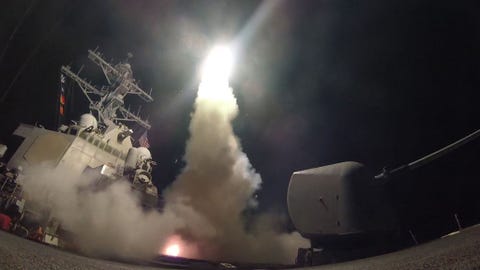By Joe Pappalardo
 This week the Russian ministry of defense showed pictures of what it claimed to be remains of U.S. cruise missiles used during the recent airstrikes on Syria. “They are now being examined by our experts,” said Col. Gen. Sergey Rudskoy. “The results of this work will be used to improve Russian weapons.” The debris shown is far from conclusive evidence, so we can't take Rudskoy's claim at face value. But for the sake of argument, let’s assume the Russians did capture significant parts of a long-range cruise missile including Tomahawks. What could its engineers do with the remains?
This week the Russian ministry of defense showed pictures of what it claimed to be remains of U.S. cruise missiles used during the recent airstrikes on Syria. “They are now being examined by our experts,” said Col. Gen. Sergey Rudskoy. “The results of this work will be used to improve Russian weapons.” The debris shown is far from conclusive evidence, so we can't take Rudskoy's claim at face value. But for the sake of argument, let’s assume the Russians did capture significant parts of a long-range cruise missile including Tomahawks. What could its engineers do with the remains?
Reverse Engineering
Any missile fired at an enemy is, by definition, considered expendable and designed to not reveal too many secrets if it malfunctions and lands intact. But there are some pieces of hardware within a modern missile that a clever enemy could exploit.

The guided-missile destroyer USS Porter fires a Tomahawk land attack missile on April 7, 2017 in the Mediterranean Sea.
This has happened before, most famously when Soviet engineers reverse engineered the Sidewinder air-to-air missile. In 1998, six Tomahawk missiles crashed in Pakistan during a volley fired at Afghan bases operated by Osama bin Laden. Pakistani and Chinese scientists reportedly scrutinized those missiles and used the lessons in their own weapons programs.
But the real value of a captured missile isn't in making a similar missile. The real value comes when you study the enemy's weapon to figure out a way to shoot it down.
The Undeath of Captured Missiles
Years ago, Popular Mechanics took a tour of BAE Systems' Jam Lab in Nashua, New Hampshire. There, the company works to thwart the anti-aircraft missiles that could target military and civilian airplanes. This struggle between Russian and U.S. engineers didn't end with the Cold War. To visit BAE's lab is to glimpse this struggle firsthand, and to see how captured hardware becomes an intelligence asset.
BAE does not buy anti-air systems from Russian or Chinese vendors. Instead, unspecified "friends of the government" (read: intelligence agencies of the U.S. and its allies) deliver missiles captured from the field. These captured missiles are subjected to a prolonged afterlife of relentless testing.
A captured missile's first stop is a clean room, where it is strapped to a testbed so engineers can study the commands that its guidance system relays to its steering fins. The jam lab researchers determine how the missile tracks its targets, and any new methods are revealed by this electronic vivisection.
This first assessment is just the beginning of a captive missile's long "undeath." Over and over, the missile's brain goes through target acquisition and tries to guide itself to a heroic, suicidal demise. Thousands of 10-minute simulations allow researchers to change variables and retest for years if need be. During the visit, PM saw a missile's brainstem that was trapped in this limbo of never-ending testing for more than seven years.
Captured missiles are also used as countermeasure guinea pigs. For example, tables equipped with mirrors guide laser beams that blind the infrared seekers on the tips of missiles. These real-word experiments also preserve data for high-fidelity simulations.
Meanwhile in Russia
The Russians have their own cruise missiles. In fact, they just proved that those weapons work by launching a long-range salvo of Kalibr missiles from warships in the Caspian Sea against what Russia called terrorist targets in Syria. The missiles use GPS and internal guidance—fairly reliable systems. However, several may have crashed along the way, evidence that guidance systems in a Tomahawk are more reliable. (Those systems augment satellites and inertial navigation with digital scene mapping.)
Russia certainly has a lab similar to BAE's where its researchers could examine undamaged seekers or communications antennas from a recovered Tomahawk and test their defenses against the American tech. Antennas can be tested for weakness to jamming, details of the engines could help detect it with infrared, and onboard navigation data can be used to inform the placement of defensive radar.
Russia’s Defense Ministry yesterday said there are plans to deliver new air defense systems to Syria “in the near future.” The continuing duel between American and Russian weapon-makers will continue. And so will the living nightmares of the captured guided missiles.
No comments:
Post a Comment